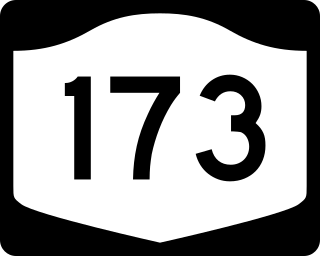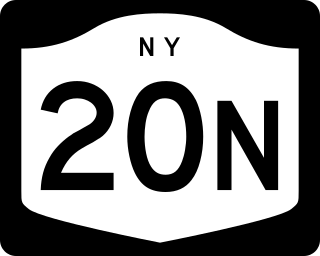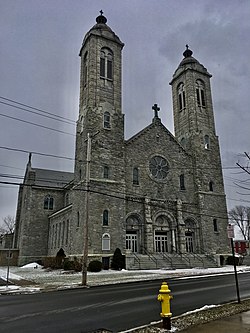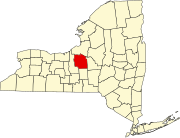
Onondaga County is a county in the U.S. state of New York. As of the 2020 census, the population was 476,516. The county seat is Syracuse. The county is part of the Central New York region of the state.

DeWitt is a town in Onondaga County, New York, United States. As of the 2020 census, the population was 26,074. The town is named after major Moses DeWitt, a judge and soldier. An eastern suburb of Syracuse, DeWitt also is the site of most of the campus and all of the academic buildings of Le Moyne College.

Fayetteville is a village located in Onondaga County, New York, United States. As of the 2020 U.S. Census, the population was 4,225. The village is named after the Marquis de Lafayette, a national hero of both France and the United States. It is part of the Syracuse Metropolitan Statistical Area.

Liverpool is a lakeside village in Onondaga County, New York, United States. As of the 2020 census, the population was 2,242. The name was adopted from the city of Liverpool in the United Kingdom. The village is on Onondaga Lake, in the western part of the town of Salina and is northwest of Syracuse, of which it is a suburb.

Lyncourt is a hamlet in Onondaga County, New York, United States. The population was 4,250 at the 2010 census.

Minoa is a village in Onondaga County, New York, United States. As of the 2020 census, the population was 3,657. Minoa is in the northern part of the town of Manlius and is east of Syracuse.

Onondaga is a town in Onondaga County, New York, United States, encompassing 65 square miles. As of the 2020 Census, the population was 22,937. The town is named after the native Onondaga tribe, part of the Iroquois Confederacy. Onondaga was incorporated April 2, 1798, and is located southwest of the city of Syracuse, which it borders. The villages and hamlets which make up the town are: Cedarvale, Howlett Hill, Navarino, Nedrow, Onondaga Hill, Sentinel Heights, South Onondaga, Southwood, Split Rock, and Taunton.

Pompey is a town in the southeast part of Onondaga County, New York. As of the 2020 Census, the population was 7,080. The town was named after the Roman general and political leader Pompey by a late 18th-century clerk interested in the Classics in the new federal republic.

Salina is a town in Onondaga County, New York, United States. As of the 2020 Census, the population was 33,223. The name of the town is derived from the Latin word for "salt." Salina is a northern suburb of Syracuse.

Manlius is a village in Onondaga County, New York, United States, and a southeast suburb of Syracuse. As of the 2020 census, the population was 4,662.

Manlius is a town to the east of Syracuse in Onondaga County. As of the 2020 Census, the population was 33,712, making it the third largest suburb in metropolitan Syracuse. In 2005, the town was ranked 98th on CNN's list of Best Places to Live.

Meadowbrook is a Syracuse, New York neighborhood, located in the southeastern corner of the city. It corresponds to Onondaga County Census Tract 46. It is named after Meadow Brook, which runs through it and into Butternut Creek.

The Old Erie Canal State Historic Park encompasses a 36-mile (58 km) linear segment of the original Erie Canal's Long Level section. It extends westward from Butternut Creek in the town of DeWitt, just east of Syracuse, to the outskirts of Rome, New York. The park includes restored segments of the canal's waterway and towpath which were in active use between 1825 and 1917. It is part of the New York State Park system.

New York State Route 173 (NY 173) is a state highway located in the Syracuse area of central New York in the United States. It takes a slightly bow-shaped route from NY 31 in the town of Van Buren to NY 5 in Chittenango, gently curving to the south of Downtown Syracuse in the center of its 30.59-mile (49.23 km) routing. Even so, NY 173 briefly enters the Syracuse city limits near where it intersects U.S. Route 11 (US 11). NY 173 passes through several suburbs of Syracuse, including Camillus, where it first meets NY 5, and Manlius, where it has a short overlap with NY 92.

New York State Route 290 (NY 290) is a state highway located entirely within Onondaga County, New York, extending from downtown Syracuse to the east side of the county. It provides access to Green Lakes State Park from the north.
Messina Springs was a small community, northwest of Messina, which was settled in the early 19th century around several mineral springs east of Syracuse, New York, United States, at the intersection of James Street and Thompson Road. James Street was then a main east–west road from Syracuse to Messina and Manlius Center. Thompson Road was a main north–south thoroughfare in eastern Onondaga County with the first bridge east of Syracuse to cross over the Erie Canal at Headson's Landing.

The East Syracuse Minoa Central School District (ESM) is a pre-K through 12th grade public school district with its headquarters in Manlius, New York, enrolling approximately 3,500 students. ESM serves portions of the towns of DeWitt and Manlius, specifically the villages of East Syracuse, Minoa, and Kirkville as well as portions of Eastwood, Fayetteville, and Bridgeport. The district is partially funded by and governed under the authority of the New York State Education Department, whose standardized examinations are designed and administered by the Board of Regents of the University of the State of New York.

New York State Route 20N (NY 20N) was a state highway in central New York in the United States. It was an alternate route of U.S. Route 20 (US 20) that stretched for 30.5 miles (49.1 km) between Marcellus and Cazenovia. The road began at its parent route, US 20, and NY 174 in Marcellus and ended at US 20, NY 20SY, and NY 92 in Cazenovia. All of NY 20N was concurrent with at least one other route, namely NY 174 in Marcellus, NY 175 from Marcellus to Onondaga Hill, NY 173 from Onondaga Hill to Manlius, and NY 92 and NY 20SY between Manlius and Cazenovia. NY 20N was assigned in May 1937 and removed in 1961 along with NY 20SY.

The Syracuse Metropolitan Statistical Area, as defined by the United States Census Bureau, is an area consisting of three counties in central New York, anchored by the city of Syracuse. As of the 2020 census, the MSA had a population of 662,057, slightly down from 662,577 in the 2010 census.

Butternut Creek is a stream in the greater Syracuse, New York area and a tributary of Limestone Creek, part of the Oneida Lake watershed. The creek is about 16 miles (26 km) long.
























